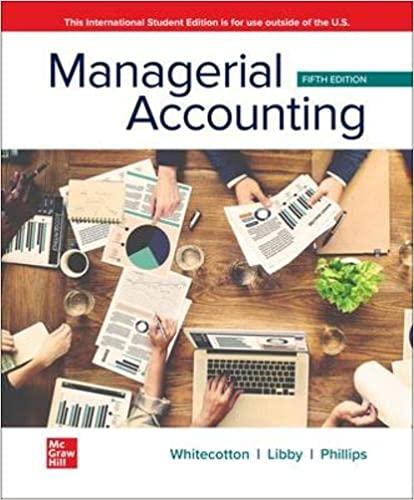Question
The pretax financial income of Oriole Company differs from its taxable income throughout each of 4 years as follows. Year Pretax Financial Income Taxable Income
The pretax financial income of Oriole Company differs from its taxable income throughout each of 4 years as follows.
| Year | Pretax Financial Income | Taxable Income | Tax Rate | ||||
| 2020 | $271,000 | $187,000 | 35 | % | |||
| 2021 | 304,000 | 228,000 | 20 | % | |||
| 2022 | 368,000 | 282,000 | 20 | % | |||
| 2023 | 423,000 | 601,000 | 20 | % | |||
Pretax financial income for each year includes a nondeductible expense of $28,300 (never deductible for tax purposes). The remainder of the difference between pretax financial income and taxable income in each period is due to one depreciation temporary difference. No deferred income taxes existed at the beginning of 2020.
Prepare journal entries to record income taxes in all 4 years. Assume that the change in the tax rate to 20% was not enacted until the beginning of 2021. (Credit account titles are automatically indented when amount is entered. Do not indent manually. If no entry is required, select "No Entry" for the account titles and enter 0 for the amounts.)
| Date | Account Titles and Explanation | Debit | Credit |
| 2020 | |||
| 2021 | |||
| (To record the adjustment for the decrease in the enacted tax rate.) | |||
| (To record income taxes for 2021.) | |||
| 2022 | |||
| 2023 | |||
eTextbook and Media
List of Accounts
Prepare the income statement for 2021, beginning with income before income taxes. (Enter negative amounts using either a negative sign preceding the number e.g. -45 or parentheses e.g. (45).)
| Oriole Company Income Statement (Partial) December 31, 2021For the Year Ended December 31, 2021For the Quarter Ended December 31, 2021 | ||
| AdjustmentCurrentDeferredDividendsExpensesIncome before Income TaxesIncome Tax ExpenseNet Income / (Loss)Retained Earnings, January 1Retained Earnings, December 31RevenuesTotal ExpensesTotal Revenues | $ | |
| AdjustmentCurrentDeferredDividendsExpensesIncome before Income TaxesIncome Tax ExpenseNet Income / (Loss)Retained Earnings, January 1Retained Earnings, December 31RevenuesTotal ExpensesTotal Revenues | ||
| AdjustmentCurrentDeferredDividendsExpensesIncome before Income TaxesIncome Tax ExpenseNet Income / (Loss)Retained Earnings, January 1Retained Earnings, December 31RevenuesTotal ExpensesTotal Revenues | $ | |
| AdjustmentCurrentDeferredDividendsExpensesIncome before Income TaxesIncome Tax ExpenseNet Income / (Loss)Retained Earnings, January 1Retained Earnings, December 31RevenuesTotal ExpensesTotal Revenues | ||
| AdjustmentCurrentDeferredDividendsExpensesIncome before Income TaxesIncome Tax ExpenseNet Income / (Loss)Retained Earnings, January 1Retained Earnings, December 31RevenuesTotal ExpensesTotal Revenues | ||
| AdjustmentCurrentDeferredDividendsExpensesIncome before Income TaxesIncome Tax ExpenseNet Income / (Loss)Retained Earnings, January 1Retained Earnings, December 31RevenuesTotal ExpensesTotal Revenues | $ | |
Step by Step Solution
There are 3 Steps involved in it
Step: 1

Get Instant Access to Expert-Tailored Solutions
See step-by-step solutions with expert insights and AI powered tools for academic success
Step: 2

Step: 3

Ace Your Homework with AI
Get the answers you need in no time with our AI-driven, step-by-step assistance
Get Started


